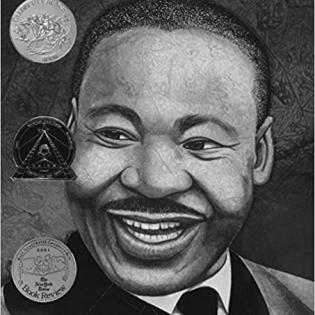Martin's Big Words Literature Guide
In the book Martin’s Big Words the partnership between the author Doreen Rappaport and the illustrator Bryan Collier results in a profound story. Through the use of Dr. King’s own words, Rappaport crafts a compelling biography. Collier’s art both illuminates and magnifies Dr. King’s life. The use of light and dark throughout the book invites the reader to feel the pain of Dr. King’s struggle and the light of hope and justice he sought to bring to the world.
Literature Guide by Maureen Klein
Before Reading
Ask: The title of the book is “Martin’s Big Words: The Life of Dr. Martin Luther King, Jr.” What do you think the author means by “big words”?
Show: Look at the first two pages of the book. What do you notice about the words themselves? If needed, prompt the listener to look at font size, color, and boldness of the words. What stands out? Dr. King’s own words help tell the story of his life. Those “big words” are emphasized throughout the text.
Connect: Before reading the book, take a “picture walk.” Show all of Bryan Collier’s images. If this were a wordless picture book, how do the images alone tell the story of Dr. King’s life and what was important to him?
During Reading
Ask: Pause on the second page of the book that begins, “In church Martin sang hymns.” Already the author is focusing on the power of words. What are some examples of words that hurt young Martin and words that helped him?
Show: Pause again on the page that reads, “Sometimes people carry signs to share their stories of resistance.” Look closely at the signs the people are holding. What do you notice about the people and their signs?
Connect: Dr. King used his words to lead the Civil Rights movement. What might be examples of words that were important to Dr. King’s leadership? If needed, go back and reread some of the quotes from earlier in the book. Which of those words stand out to you?
After Reading
Ask: Return to the beginning of the book and read the “Illustrator’s Note." Bryan Collier talks about the ways he used windows throughout the story. What windows did you notice in the story? If needed, do a brief picture walk through the book again.
Show: Show the illustrations on the page that ends with “He died." Why do you think Collier chose to depict Dr. King looking through a window on this page?
Connect: Think of a time when you were a leader. What words describe your leadership? What did you do or what actions did you take? King was a leader in the Civil Rights movement and his legacy continues to impact us today. What are some examples of his leadership in the book? If needed, prompt the readers to pay close attention to the verbs used throughout the book. Words like studied, read, listened, marched, shared, cared.
Activities
- Using the words of Dr. Martin Luther King, Jr., create a poster using art to share his message. This can be done in collage format similar to Bryan Colliers, through painting, or in a digital medium.
- Pretend you are a reporter for your local newspaper who is writing an article about Dr. King's "I Have a Dream" speech. Take notes using a graphic organizer (Who? What? Why? Where? How? When?) while listening to Dr. King’s speech. Then write a brief news article as if you were there.
- Words Matter: What words stand out to you in Dr. King's speech? Make a copy of Dr. King’s “I Have a Dream” speech. Highlight 5 words that stand out to you. Write them artistically on a page with colors and symbols. If you are in an online group, use an online word cloud platform like mentimeter.com or monkeylearn to create a group word art image from Dr. King’s words that were most impactful to your group.
- If you would like to learn more about Dr. King's focus on bringing diverse communities together for the common good, choose from these lesson plans.
- Create a Positive Pair Word Bank: There are word pairs in the book with opposite meanings: love and hate; together and separate. Write more word pairs that are opposites. Circle the word in each pair that describes your vision of a positive community. Turn one word into word art, drawing the word and adding color and design to represent its meaning.
